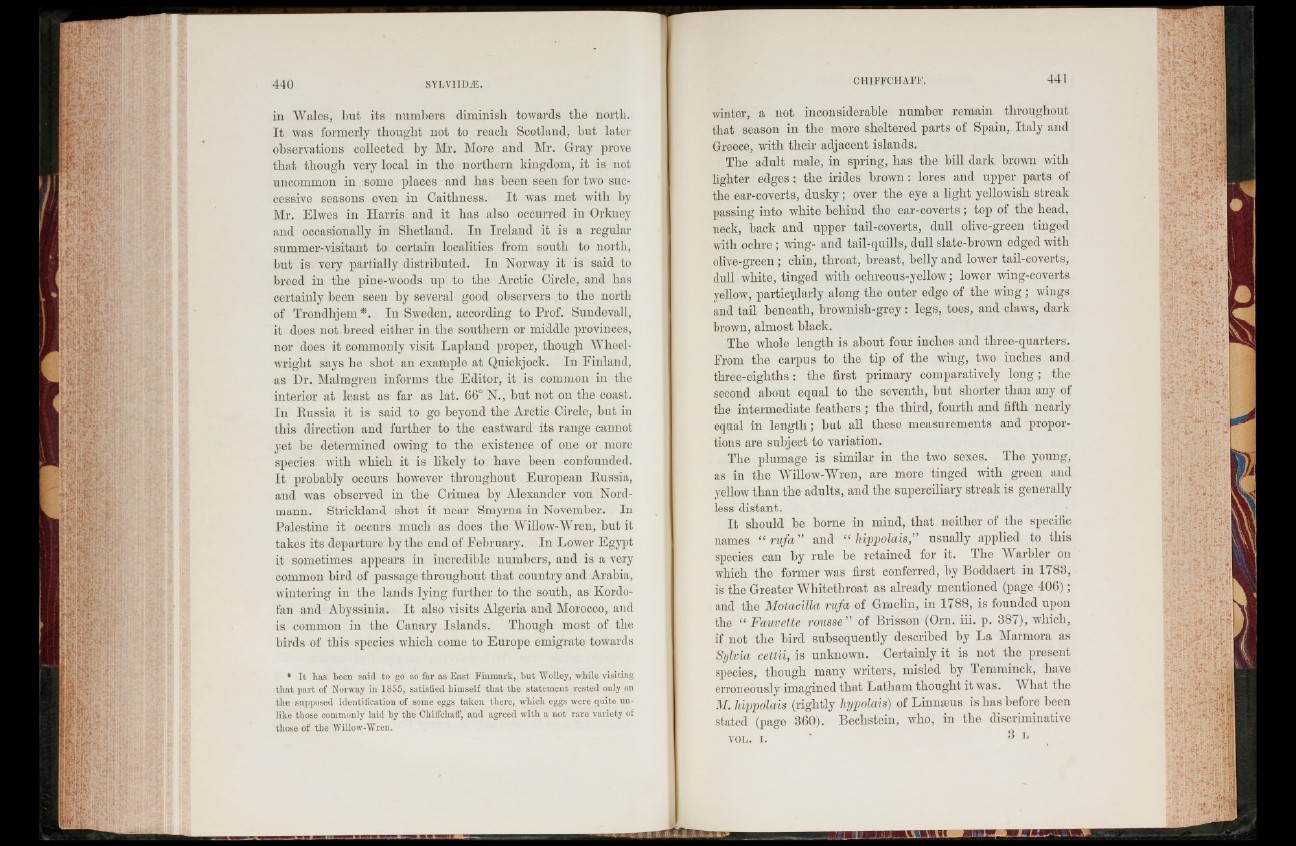
in Wales, but its numbers diminish towards the north.
I t was formerly thought not to reach Scotland, but later
observations collected by Mr. More and Mr. Gray prove
that though very local in the northern kingdom, it is not
uncommon in some places and has been seen for two successive
seasons even in Caithness. I t was met with by
Mr. Elwes in Harris and it has also occurred in Orkney
and occasionally in Shetland. In Ireland it is a regular
summer-visitant to certain localities from south to north,
but is very partially distributed. In Norway it is said to
breed in the pine-woods up to the Arctic Circle, and has
certainly been seen by several good observers to the north
of Trondlijem *. In Sweden, according to Prof. Sundevall,
it does not breed either in the southern or middle provinces,
nor does it commonly visit Lapland proper, though Wheelwright
says he shot an example at Quickjock. In Finland,
as Dr. Malmgren informs the Editor, it is common in the
interior at least as far as lat. 66° N., but not on the coast.
In Eussia it is said to go beyond the Arctic Circle, but in
this direction and further to the eastward its range cannot
yet be determined owing to the existence of one or more
species with which it is likely to have been confounded.
It probably occurs however throughout European Eussia,
and was observed in the Crimea by Alexander von Nord-
mann. Strickland shot it near Smyrna in November. In
Palestine it occurs much as does the Willow-Wren, but it
takes its departure by the end of February. In Lower Egypt
it sometimes appears in incredible numbers, and is a very
common bird of passage throughout that country and Arabia,
wintering in the lands lying further to the south, as Kordo-
fan and Abyssinia. I t also visits Algeria and Morocco, and
is common in the Canary Islands. Though most of the
birds of this species which come to Europe emigrate towards
# I t has been said to go so far as East Finmark, but Wolley, while visiting
that part of Norway in 1855, satisfied himself that the statement rested only on
the supposed identification of some eggs taken there, which eggs were quite unlike
those commonly laid by the Cliiffchaff, and agreed with a not rare variety of
winter, a not inconsiderable number remain throughout
that season in the more sheltered parts of Spain, Italy and
Greece, with their adjacent islands.
The adult male, in spring, has the bill dark brown with
lighter edges: the irides brown : lores and upper parts of
the ear-coverts, dusky; over the eye a light yellowish streak
passing into white behind the ear-coverts; top of the head,
neck, hack and upper tail-coverts, dull olive-green tinged
with ochre; wing- and tail-quills, dull slate-brown edged with
olive-green ; chin, throat, breast, belly and lower tail-coverts,
dull white, tinged with ochreous-yellow; lower wing-coverts
yellow, particularly along the outer edge of the wing; wings
and tail beneath, brownish-grey : legs, toes, and claws, dark
brown, almost black.
The whole length is about four inches and three-quarters.
From the carpus to the tip of the wing, two inches and
three-eighths: the first primary comparatively long; the
second about equal to the seventh, but shorter than any of
the intermediate feathers ; the third, fourth and fifth nearly
equal in len g th ; but all these measurements and proportions
are subject to variation.
The plumage is similar in the two sexes. The young,
as in the Willow-Wren, are more tinged with green and
yellow than the adults, and the superciliary streak is generally
less distant.
It should be borne in mind, that neither of the specific
names “ m fa ” and “ hippolais,” usually applied to this
species can by rule be retained for it. The Warbler 011
which the former was first conferred, by Boddaert in 1783,
is the Greater Whitethroat as already mentioned (page 406);
and the Motacilla rufa of Gmelin, in 1788, is founded upon
the “ Fauvette rousse” of Brisson (Orn. iii. p. 387), which,
if not the bird subsequently described by La Marmora as
Sylvia cettii, is unknown. Certainly it is not the present
species, though many writers, misled by Temminck, have
erroneously imagined that Latham thought it was. What the
M. hippolais (rightly hypolais) of Linnaeus is has before been
stated (page 360). Bechstein, who, in the discriminative
vm, t 3 L
cV . JLf ’¿'••L i-i'J 'Xj '‘(j*
■■ y :- M
1
I
f >531
• • - —